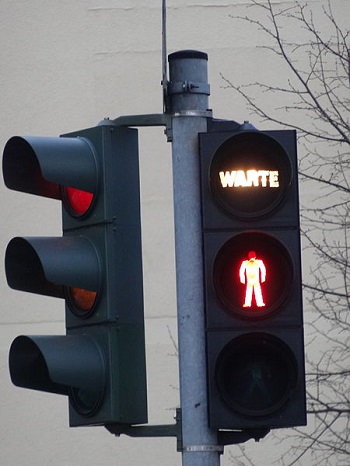German city attempts to prevent mobile users in Germany from accidentally walking out into traffic.
The German city of Augsburg has taken new measures to protect its smartphone-using residents from inadvertently ignoring red traffic lights and walking out onto a busy road by installing new traffic lights directly embedded into the pavement. The hope is that German smartphone users, who are constantly looking down at their phones, will take notice of these lights and pay more attention to their surroundings.
A growing number of pedestrians are risking their safety due to phone distraction.
According to The Washington Post, a survey that was recently conducted in several European cities, including Berlin, discovered that nearly 20% of pedestrians failed to observe the traffic signal change because they were distracted by their smartphones. The survey also found that younger mobile users who more likely to risk their safety to take a quick look at their Facebook or WhatsApp.
 That being said, this is not only a problem in Europe. The United States Department of Transportation has found a clear link between smartphone users distracted by their device and an increase in pedestrian death. According to a University of Washington study, 1 in 3 Americans is either busy working or texting on a smartphone at dangerous road crossings.
That being said, this is not only a problem in Europe. The United States Department of Transportation has found a clear link between smartphone users distracted by their device and an increase in pedestrian death. According to a University of Washington study, 1 in 3 Americans is either busy working or texting on a smartphone at dangerous road crossings.
Will installing these lights to protect German smartphone users be worth it?
Not everyone agrees that it is. The German newspaper Süddeutsche Zeitung reported that some commentators have said that they feel taxpayers’ money was wasted on the project. Another paper, Augsburger Allgemeine revealed that one young pedestrian who was asked about the lights by reporters said that he hadn’t even noticed them until the reporters had drawn his attention to them.
However, an Augsburg city spokesperson Stephanie Lermen said about the new traffic lights that they “create a whole new level of attention.” She believes the money used to install the lights was wisely spent.
What prompted the idea to install these traffic lights was the death of a teen girl, who was killed by a tram. Police reports stated that the 15-year-old had been distracted by her smartphone as she crossed the tracks.
The number of pedestrians putting their safety at risk because they’re distracted by their mobile phones appears to be a growing trend around the globe. It won’t be surprising if more measures, like the one Augsburg put into place for its German smartphone users, begin to pop up in other parts of the world to help solve this increasing problem.


